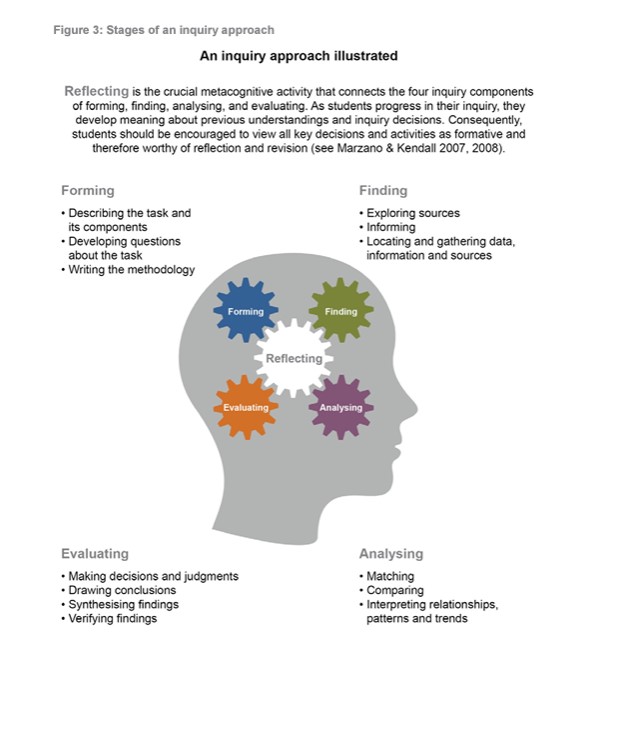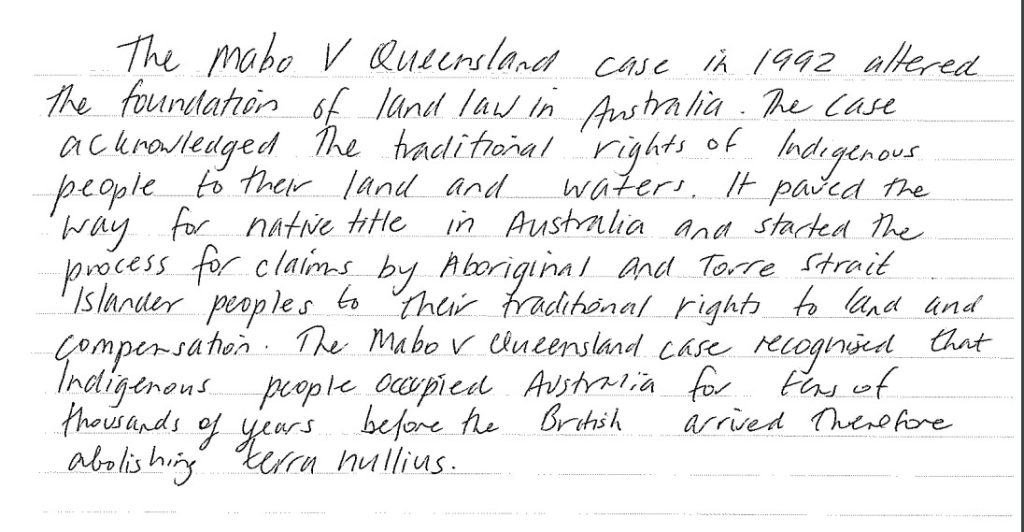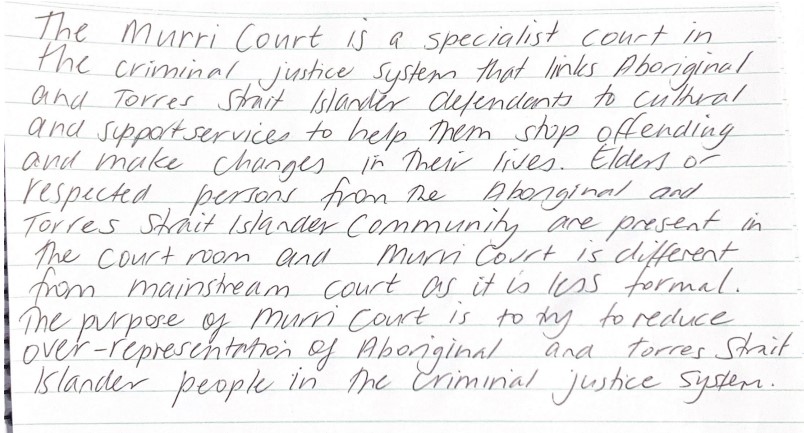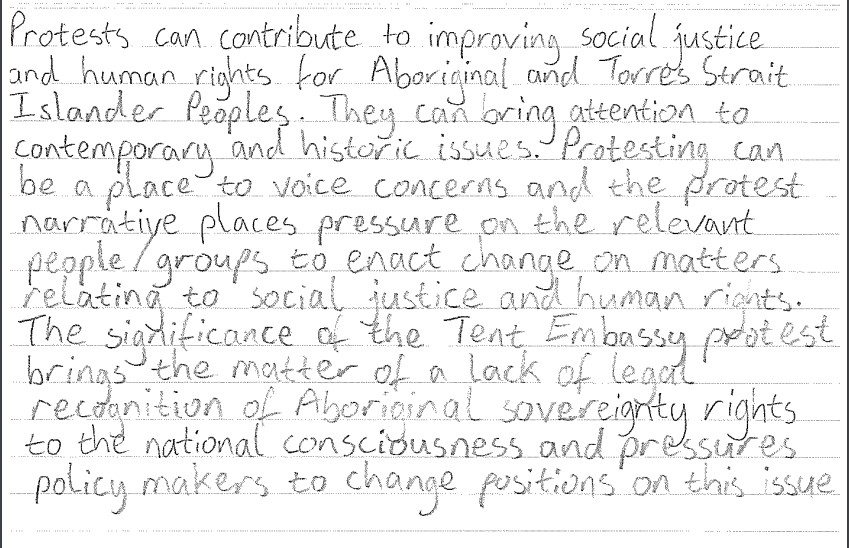Year 12 – Legal Studies (CC BY)
Subject overview
Legal Studies General Senior Syllabus (2019)
Unit overview
Legal Studies focuses on the interaction between society and the discipline of law. Students study the legal system and how it regulates activities and aims to protect the rights of individuals while balancing these with obligations and responsibilities (Queensland Curriculum and Assessment Authority [QCAA], 2022). Legal studies explores the role and development of law in response to current issues. An understanding of legal processes and concepts enables citizens to be better informed and able to constructively question and contribute to the improvement of laws and legal processes.
Unit 3, Topic 1 Law, Governance and Change
In Unit 3, students examine the complexities of the Australian legal system and its capacity to deal with the diversity of competing needs. They explore the role of legal institutions and lawmaking bodies in creating laws that reflect the views of society. Students consider the range of forces that create catalysts for change and reform, and how laws are changed to reflect shifting societal demands. This unit encourages and informs critical thinking about Australian and Queensland laws, and the importance of society and individuals engaging in lawmaking processes (QCAA, 2022).
This teacher resource for Unit 3 (law reform) overlaps with Unit 4 (Human Rights).
Core concepts and ideas
- Beyond reasonable doubt
- Balance of probabilities
- Law, governance, and change
- Human rights in legal contexts
Objectives
- Comprehend legal concepts, principles and processes
- Select legal information from sources
- Analyse legal issues
- Evaluate legal situations
- Create responses that communicate meaning
Curriculum links
This resource is aligned with the Queensland Curriculum & Assessment Authority Version 1.1 and the Australian Curriculum Cross-Curriculum Priority: Aboriginal and Torres Strait Islander Histories and Cultures.
Underpinning factors
- Literacy — the set of knowledge and skills about language and texts essential for understanding and conveying Legal Studies content.
- Numeracy — the knowledge, skills, behaviours and dispositions that students need to use mathematics in a wide range of situations, to recognise and understand the role of mathematics in the world, and to develop the dispositions and capacities to use mathematical knowledge and skills purposefully.
- 21st century skills — the attributes and skills students need to prepare them for higher education, work and engagement in a complex and rapidly changing world.
Pedagogical and conceptual frameworks
An approach to inquiry

Inquiry-based learning involves:
• a method of learning, initiated by questions or problems
• personal construction of a student’s own knowledge, i.e. knowledge that is new to the student
• an active approach to learning where students have the central role
• the teacher acting as a facilitator
• developing self-directed learning over time, as students assume increasing responsibility for their learning.
Unit objectives
- Comprehend legal concepts, principles and processes of Australian and Queensland governance and law reform
- Select legal information from sources relevant to law reform issues
- Analyse legal issues involving Australia and/or Queensland governance and law reform
- Evaluate legal situations relevant to Australian and/or Queensland governance and law reform
- Create responses that communicate meaning to suit the intended purpose
Students will be able to:
- describe the role of advocacy groups in bringing about change
- describe the difference between legislation and case law
- describe the impact that High Court decisions can have on law reform
- analyse the impact of recent decisions on case law and legislation.
Eddie Koiki Mabo
Students are asked to comprehend and analyse legal issues, concepts, and processes, evaluate legal situations, select legal information, and create responses. In this unit, students can consider the role of landmark court decisions in influencing legal change or law reform in:
- Mabo v Queensland (No. 2) (1992) 175 CLR 1; [1992] HCA 23.
- Wik Peoples v Queensland (1996) 187 CLR 1; [1996] HCA 40.
The relationship between legislation and case law, the relationship of specialist courts and tribunals with state and federal jurisdictions, e.g. the Family Court, the Children’s Court, Murri Court, Administrative Appeals Tribunal (AAT), and Queensland Civil and Administrative Tribunal (QCAT). They will analyse and evaluate the role of courts in law-making through the interpretation of statutes and the development of legal principles through the application of the doctrine of precedent.
Lesson Plan
Topic 1 Governance in Australia
Notional time: 28 hours
In Topic 1, students consider the processes and roles of government in shaping law in Australia and Queensland. They examine how federal and state or territory legal institutions respond to forces of change and the impact of landmark cases (QCAA, 2019).
Topic 1 |
Lesson Plan |
Resources |
|
Governance in Australia |
Define:
Discuss:
Activity:
|
The Law Society of NSW. (2018). What is the rule of law? [Video]. YouTube. https://www.youtube.com/watch?v=0R20U9zkMmg Rule of Law Education Centre. (n.d). Rule of Law Wheel. https://www.ruleoflaw.org.au/what-is-the-rule-of-law/ Australian Human Rights Commission.(2018). What is Democracy? [Video]. YouTube. https://www.youtube.com/watch?v=8Eu6G5YrBt4 Rule of Law Legal Studies.(2021). Magna Carta: The Foundation of the rule of law. [Video]. YouTube. https://www.youtube.com/watch?v=XuPRCV1RtZM&t=5s
|
|
The Australian Constitution |
Define:
Discuss:
Activity:
|
Australian Human Rights Commission. (2018). What is the Australian Constitution? [Video]. YouTube. https://www.youtube.com/watch?v=xyOH605fHW8 Australian Electoral Commission. (n.d). Referendums. https://www.aec.gov.au/elections/referendums/ Engage Wiki. (2015). Doctrine of Precedent. [Video]. YouTube. https://www.youtube.com/watch?v=ysfJJT6o4jM |
|
Government in Australia |
Define:
Discuss:
Activity:
|
Australian Electoral Commission. (n.d). 1999 referendum report. https://tinyurl.com/yc64uvcd Parliament of Australia. (n.d). Part V- Powers of the Parliament. https://tinyurl.com/2ud4awpf
|
|
Legislative Powers |
Define:
Discuss:
Activity:
|
Environmental Law Australia.(n.d). Tasmanian Dam Case. http://envlaw.com.au/tasmanian-dam-case/ McGrath, C. (2015). The Story of the Tasmanian Dam Case. [Video]. YouTube. https://tinyurl.com/nfjmwhpm Parliament of New South Wales. (n.d). Understanding the role of the crown in parliament. https://tinyurl.com/mrmt3hb8
|
|
Specialist courts |
Define:
Discuss:
Activity:
|
Queensland Courts. (n.d). Murri Court. https://tinyurl.com/ymtvzn85 Queensland Sentencing Advisory Council. (2020). Murri Court: Doing Justice Differently [Video]. YouTube. https://www.youtube.com/watch?v=Onl8bHr9FLM Queensland Courts. (n.d) Courts. https://www.courts.qld.gov.au/courts Moore, M. (2001). The Role of Specialist Courts : An Australia Perspective. Federal Judicial Scholarship. AustLII. https://tinyurl.com/385vu4v6
|
|
Over-representation |
Define:
Discuss:
Activity:
|
Australian Law Reform Commission. (2018). Over-representation. Australian Government. https://tinyurl.com/rpzv8anp
|
|
Effective Laws and Rights |
Define:
Discuss:
Activity:
|
Attorney-General’s Department. (n.d). Courts. Australian Government. https://www.ag.gov.au/legal-system/courts James Cook University Library. (2022). Eddie Koiki Mabo: A timeline of history in the making. James Cook University Open eBooks. https://tinyurl.com/mt9k9r2z Queensland Government. (n.d). Queensland Legislation. https://www.legislation.qld.gov.au/ State Library of New South Wales. (n.d). Precedent and Evidence. https://tinyurl.com/3e832uhw Prospero8800. (2013). Every Family’s Nightmare. [Video]. YouTube. https://www.youtube.com/watch?v=X7Db_IhQgNc Muntz, M., Punchard, E., & Redwood, J. (2013). Teacher Notes- Every Family’s Nightmare. National Film and Sound Archive. https://shop.nfsa.gov.au/every-familys-nightmare |
|
Law Reform |
Define:
Discuss:
Activity: Case Study (choose one to research in groups or pairs)
Analyse legal issues by determining the nature and scope of the issue and examining viewpoints and consequences Activity: (in pairs)
|
State Library of New South Wales. (2014). How Laws are made- parliament. Public Library Services. [Video]. YouTube. https://www.youtube.com/watch?v=lNZ8CQUak6A |
|
Case law versus legislation |
Define:
Discuss:
Activity:
|
Queensland Government. (2012). Legislation- How laws are made. https://tinyurl.com/3bdm4z69
|
Topic 2 Law reform within a dynamic society
Notional time: 15 hours
In Topic 2, students explore issues and situations where Australian society’s changing values, needs, morality, ethics, technology and significant events have acted as impetus for legal change and reform. The focus is on identifying changing Australian values and pressures on legal freedoms, and how the application of law creates a balance between competing interests. This topic offers scope to examine current and emerging legal issues in Australia and Queensland that create authentic discussions of viewpoints regarding the need for change (QCAA, 2019).
Topic 2 |
Lesson Plan |
Resources |
|
Advocacy groups |
Define:
Discuss:
Activity:
|
Australian Federation of Disability Organisations. (n.d). Disability advocacy organisations. https://www.afdo.org.au/ ANTAR.(n.d). Current Campaigns and Issues. https://antar.org.au/ Parliamentary Education Office. (2022). Conduct a law reform inquiry. Commonwealth of Australia. https://tinyurl.com/525decdx
|
|
Human rights |
Define:
Discuss: What changes have occurred around issues such as women’s rights, disability rights? Activity:
|
United Nations. (n.d). Universal Declaration of Human Rights. https://tinyurl.com/2p87ttv2 Australian Human Rights Commission. (n.d). Women’s Rights. https://tinyurl.com/5n7r774a CrashCourse. (2016). Utilitarianism: Crash Course Philosophy #36. [Video]. YouTube. https://www.youtube.com/watch?v=-a739VjqdSI
|
|
Commissions |
Define:
Discuss:
Activity:
|
Woodgate, R., Biggs, J., & Owens, D. (2018). Legal Studies for Queensland: Units 1 & 2 Volume 1 (8th ed.). Legal Eagle Publications. Office of the Townsville Coroner. (2003). Findings of Inquest. Queensland Courts. https://tinyurl.com/4wbb8ztx Hanger, I. (2014). Report of the Royal Commission into the Home Insulation Program. Analysis & Policy Observatory [APO]. https://apo.org.au/node/41087 Grattan, M. (2014). Royal Commission says insulation deaths were fault of the government’s program. The Conversation. https://tinyurl.com/4krrpxyx |
|
Tent Embassy |
Define:
Discuss: (prior knowledge)
Activity:
|
National Museum of Australia. (n.d). Defining moments: Aboriginal Tent Embassy. https://tinyurl.com/pae97eb5 Carlson, B., & Coe, L-J. (2022). A short history of the Aboriginal Tent Embassy- an indelible reminder of unceded sovereignty. Museum of Australian Democracy at Old Parliament House. https://tinyurl.com/yhjae89p Langton, M. (n.d). Sovereignty: 65,000 years of Ancestral links to land. Agreements Treaties and Negotiated Settlements. https://tinyurl.com/yc82mubj Sovereign Union-First Nations Asserting Sovereignty. (n.d). Aboriginal Sovereign Manifesto of Demands. https://tinyurl.com/mr48hejr |
|
Recognising Aboriginal and Torres Strait Islander Sovereignty
|
Define:
Discuss:
Activity:
|
Australian Human Rights Commission. (2002). Recognising Aboriginal sovereignty-implications for the treaty process. https://tinyurl.com/3zepw8dz Langdon, M. (n.d). Understanding Sovereignty. Sovereignty: 65, 000 years of ancestral links to land. Agreements Treaties and Negotiated Settlements. https://www.atns.net.au/understanding-sovereignty The Uluru Statement. (2022). The Uluru Statement From the Heart. https://ulurustatement.org/ Mackay, M. (2020). Traditional owners mark one year since closure of Uluru climb. ABC News. https://tinyurl.com/yc5z2snh
|
|
The doctrine of terra nullius |
Define:
Discuss:
Activity:
|
Clayton-Dixon, C. (2015). I can’t call myself an Indigenous Australian and also say sovereignty never ceded. The Guardian.
Justice Jagot. (2017). Opening Address to the Law Society of New South Wales Young Lawyers‘ Conference. Federal Court of Australia. https://tinyurl.com/y6ejmwnd McBride, L., & Smith, M. (2021). Terra nullius. Australian Museum. https://tinyurl.com/2nc5kv9d |
|
Impact of landmark decisions |
Discuss:
Activity
|
Q+A. (2022, June 3). The legacy of Eddie Koiki Mabo [TV series episode]. YouTube. https://youtu.be/oLaTtIcAg8w James Cook University Library. (2022). Eddie Koiki Mabo: A timeline of history in the making. JCU Open eBooks. https://tinyurl.com/4zecs3hs
|
|
The High Court’s Mabo decision |
Define:
Discuss:
Activity: The High Court’s decision was a 6:1 majority.
|
Australian Institute of Aboriginal and Torres Strait Islander Studies. (n.d). Overturning the Doctrine of Terra Nullius: The Mabo Case. https://tinyurl.com/2baf67zk |
|
Wik Peoples v Queensland (1996). |
Define:
Discuss:
Activity:
|
Australian Institute of Aboriginal and Torres Strait Islander Studies. (n.d). Case Summary: Wik Peoples v Queensland. https://aiatsis.gov.au/publication/35303 Durmush, G. (2018). Explainer: Wik Vs. Queensland. National Indigenous Television. https://tinyurl.com/mu47f5u Attorney-General’s Department. (n.d). Native Title. Australian Government. https://tinyurl.com/bdza5uwn Federal Register of Legislation. (1993). Native Title Act 1993. Australian Government. https://tinyurl.com/5yu4bhze James Cook University Library. (n.d.). Virtual tour of the Mabo Timeline interpretative wall. https://tinyurl.com/2p9a2kup |
|
Reflection |
Define:
Discuss:
Activity:
|
Lawrence, C., Flynn, L., & Harris, I. (2022). Native title compensation: Not much to see but plenty happening below the surface. https://tinyurl.com/5n7mv3tb Miller, I. (2022). The legacy of Eddie Koiki Mabo: Mabo Day. Queensland Museum Network. https://tinyurl.com/2e572chh |
Assessment
Topic: Mabo
Internal Assessment 1: Possible practice short response questions
High-level response:

Transcript:
The Mabo v Queensland case in 1992 altered the foundation of land law in Australia. The case acknowledged the traditional rights of Indigenous people to their land and waters. It paved the way for native title in Australia and started the process for claims by Aboriginal and Torres Strait Islander peoples to their traditional rights to land and compensation. The Mabo v Queensland case recognised that Indigenous people occupied Australia for tens of thousands of years before the British arrived, therefore, abolishing terra nullius.
Topic: Specialist Courts
Internal Assessment 1: Possible practice short response questions
Describe the Murri Court and explain its purpose in the Queensland Court structure.
High-level response:

Transcript:
The Murri Court is a specialist court in the criminal justice system that links Aboriginal and Torres Strait Islander defendants to cultural and support services to help them stop offending and make changes in their lives. Elders or respected persons from the Aboriginal and Torres Strait Islander community are present in the court room and Murri Court is different from mainstream court as it is less formal. The purpose of Murri Court is to try to reduce over-representation of Aboriginal and Torres Strait Islander people in the criminal justice system.
Practice Extended Response- Judicial activist using the decision of Mabo as an example
- Analyse sources 1-6 to determine the nature and scope of the legal issue, and examine two viewpoints.
- Evaluate whether the High Court of Australia should have the ability to make law. In your evaluation, consider two possible alternatives and decide about the best way to achieve just and equitable outcomes.
|
1 |
Mikiandme. (2015, September 30). Critical Legal Thinking. MIKIANDME. https://mikiandme.wordpress.com/
An interesting point came up while reading about critical legal studies in that legal realists and critical legal scholars believed that judges when making their decisions conceal the true nature of the decision under the guise of an objective rather than subjective position. Well of course they do. It would be inherently impossible for any person to use a truly objective position in making any decision. It is to the very core of our human nature to form subjective opinions and even make subjective decisions or determinations. Oh, we say they are objective to appease the need of law, but it would be truly impossible to be purely objective in any thought process. We will always be influenced by our internal governance. I don’t think it is deliberate and possibly that is why judges use elaborate rationalizing, not to disguise what they are saying, but rather to ensure they are being as objective as is humanly possible.
|
| 2 |
French, R.S. (2009, November). Judicial Activism – The Boundaries of the Judicial Role. [Paper presentation]. Law Asia Conference 2009, Ho Chi Minh City, Vietnam. https://tinyurl.com/2mxvxr2m Much room is left for judges in the interpretation process to determine what the law is. But if that occasions complaint then the complaint is misconceived. The meanings of legislative words are not like rocks lying around on the ground waiting to be picked up. They are necessarily products of interpretation. That interpretation is legitimate when it is principled and invokes criteria which, whether developed by courts or decreed by statute or both, are broadly understood by the legislature, the executive and the judiciary. And to that extent they represent another example of a necessary, legitimate and generally accepted authority to the judges to determine what the law is by determining what it means.
|
| 3 |
Kirby, M., (2006). Judicial Activism: Power without Responsibility? No, appropriate activism conforming to duty. University of Melbourne. https://tinyurl.com/27k9sn8y Judicial activism: power without responsibility? The decision in Mabo changed the line of legal authority, for two reasons. The first was the acceptance
|
| 4 |
Allan, J.,(2012). “The Three ‘Rs’ of Recent Australian Judicial Activism: Roach, Rowe and (No)’Reginalism.” Melbourne University Law Review. Auslii. https://tinyurl.com/2p8sj35z Judicial activism … undermines the rule of law in its old-fashioned procedural sense of the desirability of
|
| 5 |
Sakr, J.M., & Zimmermann, A. (2021). Judicial Activism and Constitutional (Mis)Interpretation. University of Queensland Law Journal 40(1), 119-143. https://tinyurl.com/4n7ck6s3
Judicial Activism and Constitutional (Mis)Interpretation: A Critical Appraisal. Such an approach regards judicial activism as always preferable, while an intentionalist or purposive
|
| 6 | Josev, Tanya., (2016, April 11). Twenty years after the High Court’s Wik decision, how does the ‘judicial activism’ charge stand up? The Conversation. https://tinyurl.com/3nwt59nd
It is no coincidence that the rise of the “judicial activism” terminology coincided not only with the Wik decision but also with the new Coalition government’s campaign to ensure all arms of government focused on the protection of “mainstream” interests. The Coalition argued these had been ignored at the expense of progressive, boutique interests during the Keating government years.’
|
Assessment – Short Response Questions
Explain how protests can contribute to improving social justice and human rights for Aboriginal and Torre Strait Islander Peoples. Make sure you provide examples in your answer.
The answer should include:
- Protests can contribute to improving social justice and human rights.
- Bring attention to both contemporary and historic issues.
- The place to voice concerns.
- The narrative generally seeks to pressure those relevant people/groups to enact
change on matters relating to social justice and human rights. - The significance of this protest brings the matter of a lack of legal recognition of Aboriginal and Torres Strait Islander sovereignty rights to the national consciousness and pressures policymakers to change their position.
Possible examples:
- The Tent Embassy
- Australia Day (Invasion Day) protests
High-level response:

Transcript:
Protests can contribute to improving social justice and human rights for Aboriginal and Torres Strait Islander peoples. They can bring attention to contemporary and historic issues. Protesting can be a place to voice concerns and the protest narrative places pressure on the relevant people/groups to enact change on matters relating to social justice and human rights. The significance of the Tent Embassy protest brings the matter of a lack of legal recognition of Aboriginal sovereignty rights to the national consciousness and pressures policy makers to change positions on this issue.
References
Gray, A., & Herlihy, G. (2004). Legal Studies in Action. Jacaranda.

